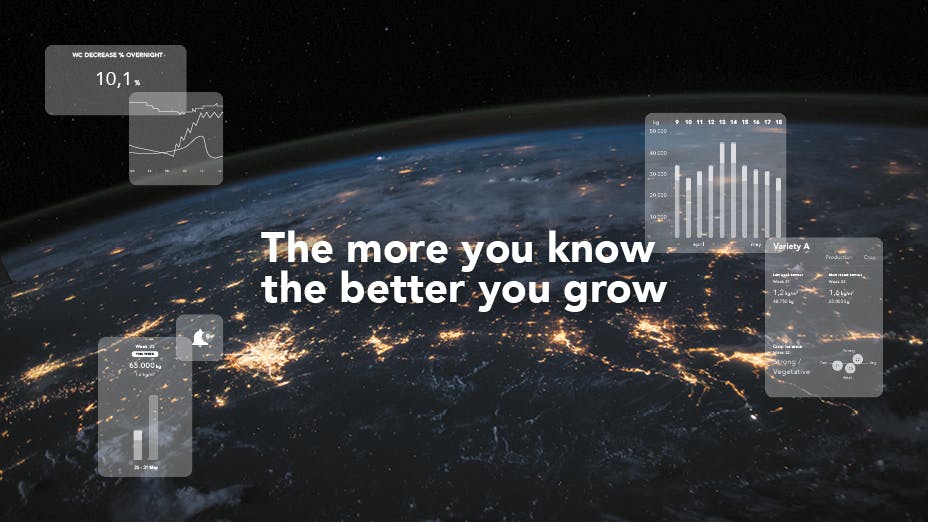Karacor has a mission, and that mission is that these pioneering technologies will actually be used by growers. With over 20 years of practical experience, he understands the technology, as well as growers' concerns, like no other. But what do all these developments mean for growers? Before we get into that, a brief description of exactly how AI works.
Medium describes it as follows: "Artificial Intelligence (AI) involves the use of computers for things that previously required human thinking. Briefly, it consists of developing algorithms to classify, analyse data and make predictions. It also includes responding to data, learning from new data and improving over time based on the data."
Karacor explains the five main reasons why AI will change the way you work (for the better):
1. Demand for food will continue to rise
The need for fresh and sustainable food grown efficiently is ever increasing. Agricultural land and labour in non-urban areas are becoming increasingly scarce, while the demand for food and fresh Products is increasing. "I think Greenhouses and other indoor cultivation options are going to play an increasing role to continue to meet the demand for food in the Future. For this reason, using artificial intelligence as a supporting tool is now more important than ever," Karacor explains.
2. The technology is mature enough
We asked Karacor what he thinks are the most important trends and issues in the greenhouse horticulture sector right now.
- Machine learning (ML) is a subcategory of AI and includes software that learns from data; purely data-driven, in other words. As seen above, there is quite a lot of data and potential to collect this big data in the greenhouse.
- Image technology or image recognition allows equipment to learn to "see" by using pictures. "They say: a picture says more than a thousand words," and that is totally true here, notes Karacor. "Image technology works more easily than sensor data and manual recordings."
- Robots are autonomous or semi-autonomous machines that can be used for certain, often tedious, time-consuming or dangerous activities or tasks with a lot of repetition.
- Edge-AI: Standard AI calculations and modelling are performed on a server or in the cloud (which is time-consuming), with Edge-AI all calculations take place in so-called edge environment on the device or robot. The calculations take place on the robot itself, which allows decisions to be made much faster. This is particularly important for real-time operations.
3. Growers are ready for it
Growers are keeping a close eye on technological developments. However, they still have many questions, such as I have a huge amount of data, but how can I use it? Am I lagging behind my competitors? Is my cultivation strategy optimal? But according to Karacor, they are open to learning and eager to start using the data they receive through popular technologies such as AI.
4. Big data enables individual and local solutions
The quality and quantity of data is of huge importance, but many growers consider collecting it tedious. But even with just a few photos AI technologies can support growers, for example, in recording their crop. Data can be used for many different purposes, including for developing forecasts. For example, e-Gro, Grodan's latest innovation, allows growers to make a harvest forecast for the next four weeks. In addition, growers can benefit from more general AI-based forecasts and data-driven crop advice. Big data can also be used for individual intelligent solutions in the greenhouse. Experts often name general rules, but specific growers in certain regions with specific climates need tailor-made solutions. "That will really make a difference," says Karacor. "With a continuous flow of big data, growers can benefit from all the advantages of machine learning and AI. That's very interesting."
5. Automation for optimal efficiency
In greenhouse farming, a lot is still done by hand, such as planting, registering, harvesting, etc. These are tedious, labour-intensive tasks with a lot of repetition that could also be done by robots, for example. Automation is important not only for increased efficiency, but also to address health and safety challenges, for example to prevent the spread of viruses and bacterium and diseases (by reducing contact between people and between people and the crops); the COVID-19 pandemic made us realise its importance even more.
Karacor's advice regarding the last point: "The good thing is that these solutions are user-friendly. If you work with the right people, it will prove surprisingly easy and very rewarding."
Where botany and data science meet
For the new crop forecasting module, Grodan has combined the power of data science with 50 years of crop growing expertise. The innovative technology that analyses all available data in your Greenhouse finds the patterns and critical factors that affect harvest. The result is a new AI-based module for crop forecasting; a valuable addition to the egro platform. Click here for more information on the egro platform.
The autonomous Greenhouse: within five years?
Future Greenhouses will become increasingly autonomous. AI solutions will make the lives of experts and growers a whole lot easier. "My mission is the realisation of the autonomous Greenhouse through the use of data combined with advanced AL and AI methodologies," concludes Karacor. "And I want to achieve that goal step by step, within five years." The Future may be closer than you think.
More information on modern technologies can be found in the article "Greenhouse innovations all growers should know about".

Where the magic happens: the potential of data-driven decision-making
Cultivation, analysis and automation based on digital data are the Future for the greenhouse horticulture sector. Artificial intelligence (AI) and data science are going to deliver breakthrough efficiencies and higher yields. But what exactly do these technologies entail? How do they work? And how can growers actually benefit from them?





